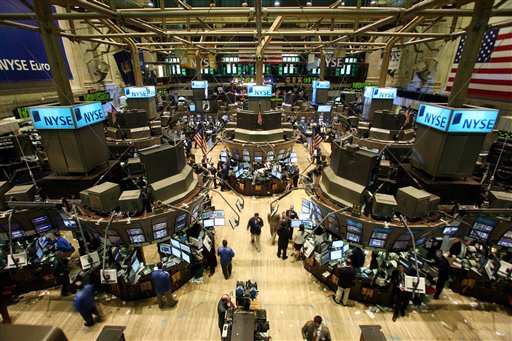
Wall Street ended a tumultuous two-week run relatively quietly
Friday, finishing another back-and-forth session mixed as investors
were cheered by signs of easing in the credit markets and managed
to absorb lackluster economic news with equanimity.
TIM PARADIS – Associate Press
NEW YORK
Wall Street ended a tumultuous two-week run relatively quietly Friday, finishing another back-and-forth session mixed as investors were cheered by signs of easing in the credit markets and managed to absorb lackluster economic news with equanimity.
The expiration of options contracts helped tug the market in different directions throughout the session. Still, the Dow Jones industrial average traded within a narrower range than it had in much of the past two weeks. The Dow ended down 127 but big rallies on Monday and Thursday gave the blue chips an advance of 4.8 percent for the week – the best gain since March 2003.
The market spent the first half of the session vacillating, moving between gains and losses after the government said new home construction dropped by more than expected last month to the lowest pace since early 1991. But investors’ mood seemed to pick up later in the session as lending rates for bank-to-bank loans eased, indicating some bank fears about not being repaid by borrowers is easing. Demand for safe-haven investments like Treasury bills also decreased. The final hour of trading again proved pivotal as in much of October; stocks fluctuated as investors squared away positions for the week.
Given the magnitude of most of the recent sessions in October, the indexes’ moderate declines Friday seemed barely noteworthy. And advancing issues outnumbered decliners by about 3 to 2 on the New York Stock Exchange, where volume came to 1.74 billion shares.
The loosening of credit markets appeared to draw most of investors’ attention. The London interbank offered rate, or Libor, for three-month dollar loans fell to 4.41 percent from 4.50 percent Thursday, the fifth consecutive day of declines.
“I think we’re beginning to get a slightly better feeling in the credit market,” said Peter Cardillo, chief market economist at Avalon Partners Inc., a New York brokerage house, pointing to the move in Libor. “I’m sure we’ll still have a strong bear grip to the market but I do believe the market was way oversold. I do believe we’ve made a bottom.”
It was an erratic week on Wall Street, with the Dow soaring 936 points on Monday, slipping moderately Tuesday, sinking 733 points Wednesday, and then rallying 401 Thursday. The volatility is not providing investors with much relief, but it is a welcome change from last week’s relentless plunge, during which the Dow logged its worst week ever and Wall Street lost about $2.4 trillion in shareholder wealth.
According to preliminary calculations, the Dow Jones industrial average fell 127.04, or 1.41 percent, to 8,852.22, after falling 261 points in the early going and rising 302 points – a 563-point range.
Broader stock indicators showed more modest declines. The Standard & Poor’s 500 index fell 5.88, or 0.62 percent, to 940.55, while the Nasdaq composite index fell 6.42, or 0.37 percent, to 1,711.29.









